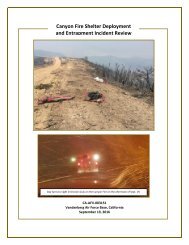Final Report to the Joint Fire Science Program
13-1-04-45_final_report
13-1-04-45_final_report
Create successful ePaper yourself
Turn your PDF publications into a flip-book with our unique Google optimized e-Paper software.
Coop & Magee P-J Fuel Treatment Effects 12/31/2016<br />
initiation of our study in 2012 <strong>the</strong> Bureau of Land Management Royal Gorge Field Office (BLM<br />
RGFO) conducted over 300 fuels reduction treatments on nearly 6900 ha of P-J woodlands,<br />
including 2800 ha of mastication treatments (Matt Rustand, Wildlife Biologist, BLM RGFO,<br />
personal communication). We contrasted response variables of interest in a series of treatmentcontrol<br />
pairs that included 24 mastication and 5 hand-thin treatments. We conducted occupancy<br />
analysis of bird observation data at two scales. Local scale occupancy reflects <strong>the</strong> bird’s habitat<br />
selection at <strong>the</strong> scale of its terri<strong>to</strong>ry and represents direct habitat features selected by birds that<br />
would be altered by forest thinning treatments. Landscape scale occupancy reflects use of home<br />
range and provides a more regional understanding of bird distributional changes in relation <strong>to</strong><br />
treatments. Because our study area embodied a chronosequence of 1-11-year-old treatments and<br />
a climate gradient, we also examined <strong>the</strong> effects of time-since-treatment and regional climate on<br />
birds, vegetation and fuels. <strong>Final</strong>ly, we used our measured fuel data <strong>to</strong> develop cus<strong>to</strong>m models of<br />
fire behavior in treated and untreated stands under a range of fuel moisture scenarios, and we<br />
also simulated <strong>the</strong> effects of treatment modifications intended <strong>to</strong> increase fire resistance of<br />
residual trees.<br />
Study Methods<br />
Study Site<br />
Our study encompassed piñon-juniper woodlands in <strong>the</strong> Arkansas River valley between Salida<br />
and Cañon City, Colorado (Figure 1), within lands managed by <strong>the</strong> BLM RGFO. Elevation<br />
across <strong>the</strong> study area ranges from 1,600 m <strong>to</strong> over 3,900 m; <strong>the</strong> elevation of Salida is 2,160 m<br />
and <strong>the</strong> elevation of Cañon City is 1,615 m. Piñon-juniper woodlands occupy upland sites at<br />
elevations < ca. 2,500 m. The BLM RGFO study area embodies a climate gradient: cooler and<br />
drier in <strong>the</strong> west and warmer and wetter in <strong>the</strong> east. Within our study area, we identified 24<br />
different mastication and 5 hand-thin treatment units, each paired with an adjacent, untreated<br />
control unit, for field measurements of birds, vegetation, and fuels. Unit selection criteria<br />
included correct vegetation type (P-J woodlands), adequate area for four sample plots separated<br />
by >200 m, and accessibility. The treatments we examined were implemented between 2003 and<br />
2014. Within each unit, we installed at random four sample plots separated by >200 m, for a <strong>to</strong>tal<br />
of 232 sample plots. Plot center locations (UTMs; NAD 83) were marked with survey stakes and<br />
recorded using a handheld GPS unit. At each plot, we conducted bird point counts and measured<br />
vegetation and fuels.<br />
Field Measurements<br />
We conducted 10-minute point counts at each point count station during each of three sessions in<br />
2014 and 2015: May 15-31 (1 st session), June 1-15 (2 nd session), and June 16-30 (3 rd session).<br />
Sampling was restricted <strong>to</strong> a five- hour time window (0500-1000 hr) each morning. During<br />
sampling, every bird that was seen or heard was identified and recorded, along with type of<br />
detection (visual vs. aural). We also indicated whe<strong>the</strong>r birds were located outside <strong>the</strong> intended<br />
sampling area and treatment or control site (for example, flying over, in adjacent agricultural<br />
fields, or o<strong>the</strong>r habitat types). Wea<strong>the</strong>r conditions were recorded, including wind speed, sky<br />
conditions, and air temperature.<br />
4




